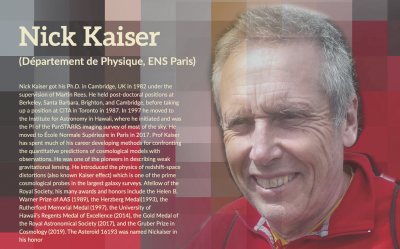In this talk I review the development of gravitational lensing in cosmology - a subject which is entering a "golden age" with the advent of Euclid and LSST. I start with Newton, who, it seems, understood light deflection but didn't get cosmology right, and follow the trail to Einstein's calculation of light bending by the sun and its generalisation to light propagation in a lumpy universe. I describe early exciting, but puzzling, applications to quasar-galaxy associations and galaxy-galaxy lensing and how, in particular, Tony Tyson's group's measurement of distortion of the "cosmic wallpaper" by galaxy clusters triggered the development of modern weak lensing. Finally, I shall discuss the insight that Raychauhuri's approach to light propagation brings to this subject.
About the speaker: Nick Kaiser got his Ph.D. in Cambridge, UK in 1982 under the supervision of Martin Rees. He held post-doctoral positions at Berkeley, Santa Barbara, Brighton, and Cambridge, before taking up a position at CITA in Toronto in 1987. In 1997 he moved to the Institute for Astronomy in Hawaii, where he initiated and was the PI of the PanSTARRS imaging survey of most of the sky. He moved to École Normale Supérieure in Paris in 2017. Prof Kaiser has spent much of his career developing methods for confronting the quantitative predictions of cosmological models with observations. He was one of the pioneers in describing weak gravitational lensing. He introduced the physics of redshift-space distortions (also known Kaiser effect) which is one of the prime cosmological probes in the largest galaxy surveys. A fellow of the Royal Society, his many awards and honors include the Helen B. Warner Prize of AAS (1989), the Herzberg Medal (1993), the Rutherford Memorial Medal (1997), the University of Hawaii’s Regents Medal of Excellence (2014), the Gold Medal of the Royal Astronomical Society (2017), and the Gruber Prize in Cosmology (2019). The Asteroid 16193 was named Nickaiser in his honor.
This lecture is part of the program "Largest Cosmological Surveys and Big Data Science".


